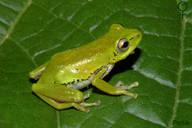|
Hyperolius cinnamomeoventris Bocage, 1866
Cinnamon-bellied Reed Frog | family: Hyperoliidae genus: Hyperolius |
 © 2017 Daniel Portik (1 of 23) |
|
|
|
Description H. cinnamomeoventris is among the very few Hyperolius to be found both in forest (although in clearings) and savanna localities. There might be small morphological differences between the bushland and savanna populations and in Cameroun. Amiet has noted differences in the voice between such populations. It is thus not unlikely that two very similar, cryptic species are involved. H. cinnamomeoventris is very similar to the sympatric H. kivuensis, and some specimens may be impossible to identify. H. cinnamomeoventris is generally smaller, with a shorter snout, smaller gular flap and more distinct light dorsolateral stripe in males. In H. kivuensis both sexes have the same pattern, while in H. cinnamomeoventris the females are green. H. cinnamomeoventris is also very similar to some populations of H. lateralis. The best distinguishing character is the entirely different voice. Finally, it resembles the poorly known H. schoutedeni. The males may be inseparable, but the female of schoutedeni has the same colour-pattern as the male. Distribution and Habitat Country distribution from AmphibiaWeb's database: Angola, Cameroon, Congo, Congo, the Democratic Republic of the, Equatorial Guinea, Gabon, Kenya, Rwanda, Tanzania, United Republic of, Uganda, Zambia
Life History, Abundance, Activity, and Special Behaviors The eggs are unpigmented, the jelly milky. Comments This account was taken from "Treefrogs of Africa" by Arne Schiøtz with kind permission from Edition Chimaira publishers, Frankfurt am Main. This species was highlighted in News of the Week January 10, 2022: Wetlands provide fundamental ecosystem services and important habitat for many species, including amphibians. However, for much of the world, we lack basic information on how wetlands are being impacted by human activities, or on policy that protects them from degradation. Mind'je and colleagues (2021) assessed land use change from 2000 to 2018 in an urban wetland in Kigala, Rwanda, by surveying plant and frog diversity to understand the implications of land use change for biological communities, and by surveying local residents with a questionnaire. They found about two-thirds of wetlands that existed in 2000 had been lost by 2018 – urban development, which was just beginning to impinge on the wetland at the beginning of the study, rapidly expanded to cover three-quarters of the study area by the end. A quarter of local residents had moved there within the last 6 years and, beyond new settlements, this wetland is largely impacted by agriculture, irrigation, and waste dumping. Along the development of the wetland, the authors found that the wetland plant and frog communities were now dominated by disturbance-tolerant, generalist species (e.g., Phrynobatrachus natalensis, Kassina senegalensis, Ptychadena spp., Hyperolius kivuensis, H. viridiflavus). More sensitive or specialized amphibians (e.g., Hyperolius lateralis and H. cinnamomeoventris) were no longer present. The authors point to the urgent need for local conservation, education, and restoration work. (Emma Steigerwald)
References
Lötters, S., Gossman, V., Obame, F., and Böhme, W. (2001). ''Zur Herpetofauna Gabuns. Teil 1: Einleitung, Untersuchungsgebiet und Methodik, kommentierte Artenliste der gefundenen Froschlurche. [The herpetofauna of Gabon. Part 1: Introduction, study area and methodology, annotated species list of recorded anurans.].'' Herpetofauna (Wiesenstadt), 23, 19-34. Schiøtz, A. (1999). Treefrogs of Africa. Edition Chimaira, Frankfurt am Main. Originally submitted by: Arne Schiøtz (first posted 2001-01-10) Description by: Michelle S. Koo (updated 2022-01-09)
Comments by: Michelle S. Koo (updated 2022-01-09)
Edited by: Kellie Whittaker, Michelle S. Koo (2022-01-09) Species Account Citation: AmphibiaWeb 2022 Hyperolius cinnamomeoventris: Cinnamon-bellied Reed Frog <https://amphibiaweb.org/species/518> University of California, Berkeley, CA, USA. Accessed Feb 5, 2025.
Feedback or comments about this page.
Citation: AmphibiaWeb. 2025. <https://amphibiaweb.org> University of California, Berkeley, CA, USA. Accessed 5 Feb 2025. AmphibiaWeb's policy on data use. |



 Map of Life
Map of Life